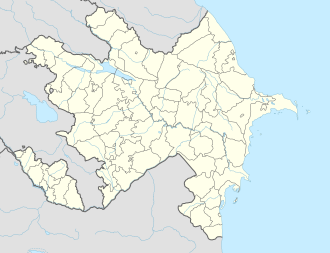Top Qs
Timeline
Chat
Perspective
Kolatak
Village in Kalbajar District, Azerbaijan From Wikipedia, the free encyclopedia
Remove ads
Kolatak (Armenian: Քոլատակ; Azerbaijani: Kolatağ) is a village located in the Aghdara District of Azerbaijan, in the region of Nagorno-Karabakh. Until 2023 it was controlled by the breakaway Republic of Artsakh. The village had an ethnic Armenian-majority population[2] until the exodus of the Armenian population of Nagorno-Karabakh following the 2023 Azerbaijani offensive in Nagorno-Karabakh.[3]
Situated on a mountain above the village is the Armenian monastery of Hakobavank, from between the 7th and 13th centuries.
Remove ads
History
During the Soviet period, the village was a part of the Mardakert District of the Nagorno-Karabakh Autonomous Oblast.
Historical heritage sites
Historical heritage sites in and around the village include the monastery of Hakobavank (Armenian: Հակոբավանք; also known as the monastery of Metsaranits, Մեծառանից) from between the 7th and 13th centuries, the fortress of Kachaghakaberd (Armenian: Կաչաղակաբերդ) in the mountains to the south - an important fortress in the medieval Armenian Principality of Khachen, the medieval fortress of Berdakar (Armenian: Բերդաքար), khachkars from between the 9th and 13th centuries, the church of Koshik Anapat (Armenian: Կոշիկ անապատ), the fortress of Isarantsots (Armenian: Իսարանցոց) and a cemetery from between the 12th and 13th centuries, a 13th-century church, the village of Alan Veran (Armenian: Ալան Վերան) and a cemetery from between the 16th and 18th centuries, the 17th-century Mandur Church (Armenian: Մանդուռի եկեղեցի, romanized: Manduri Yekeghetsi), the 17th/18th-century village of Hndzan (Armenian: Հնձան), a 19th-century oil mill, and a cave.[1]
Remove ads
Economy and culture
The population is mainly engaged in agriculture and animal husbandry. As of 2015, the village has a municipal building, a secondary school, and a medical centre.[1]
Demographics
The village had 273 inhabitants in 2005,[4] and 250 inhabitants in 2015.[1] In August 2025 the 26 Azerbaijani families, totaling 89 individuals, have been resettled in Kolatagh village of Aghdara District.[5]
Gallery
- A view of the village
- Hakobavank complex
- Scenery around Kolatak
- Armenian-language inscription in the monastery of Hakobavank
- Mountains around Kolatak
- The 12th/13th-century Koshik Anapat Church
References
External links
Wikiwand - on
Seamless Wikipedia browsing. On steroids.
Remove ads









